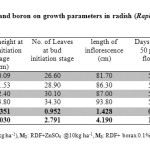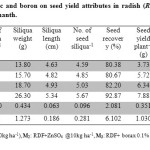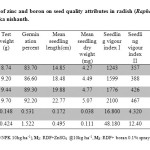Introduction
Radish is one of the important root vegetable extensively grown in almost all parts of the country .It can be considered an annual as well as a biennial crop. It is cool season vegetable. Radish plays a vital role in the health and nutritional security of human beings in addition to improve the economy of the people of the country. Zinc plays vital role in the metabolic activities of plants. The principal function of zinc in plant is as a metal activator of enzymes. Boron, on the other hand is considered to be necessary for hormone metabolism, photosynthetic activities, cellular differentiation and water absorption in plant parts. Good quality seed is also one of the important means to increase productivity in any seed crop. In this view, the present investigation initiated to know the effect of zinc and boron on growth, seed yield, quality of radish (Raphanus sativus L.) in cv. Arka nishanth.
Materials and Methods
The experiment was conducted during rainy season of 2013 at ZARS, Navile, UAHS and Shimoga .Nutrients levels four. M1: RDF 75:40:40 NPK kg ha-1 , M2:RDF+ZnSo4 @10 kg ha-1, M3:RDF + Borax 0.1% spray at bud initiation stage , M4: RDF + ZnSo4 @ 10 kg ha-1 + Borax 0.1% spray at bud initiation stage were tested in Factorial Randomised Block Design replicated thrice, plot size gross 2.5mt×4.2mt, Net plot 1.5mt ×4.2m , spacing of radish row to row 60cm and plant to plant 30cm.Radish steckling were raised on ridges and 40-45 days old and uniform stecklings were selected. One-third portion of root and shoot was cut to the original root and shoot formed without giving any injury to central growing point. The growth, seed yield and quality parameters viz., Plant height and No. of leaves at bud initiation stage (cm), length of inflorescence (cm), Days to 50 per cent flowering, Days to maturity, Number of siliqua per plant, siliqua weight per plant (g), siliqua length (cm), No. of seeds per siliqua, Seed recovery (%),Seed yield plant-1 (g), seed yield plot-1 (g), seed yield (kg ha-1),test weight (g), germination percent, mean seedling length (cm), mean seedling dry weight (mg), seedling vigour index I&II, electrical conductivity (µS ppm-1) ,total dehydrogenase activity (0D value) and data were analyzed as suggested by Sundaraju et al. (1972) .The crop raised in sandy loam soil, fertility status as envisaged through the status of available N is low (178.60 kg ha-1),P2O5 is high (68.70 kg ha-1),K2O is medium (167.60 kg ha-1) range having soil reaction in the acidic pH (5.86),micronutrients like boron is low (0.43 mg kg-1 ) ,Zinc also low (0.46 mg kg-1).
Results and Discussion
The results obtained from the present investigation have been discussed in the following sub heads.
Growth Attributes
Growth parameters like plant height (33.80 cm) and number of leaves per plant (34.30) at bud initiation stage, length of inflorescence (93.80 cm), days to maturity (94.90), 50 per cent flowering (54.90) were significantly affected by M4 treatment combination of RDF + ZnSo4 @ 10 kg ha-1 + Borax (0.1%) spray at bud initiation stage (Table 1) over other treatments except followed by M3 and M2 treatment. Fewer days taken for 50 per cent flowering in M4 treatment (54.90 days) and same result shown in days taken for maturity (94.90days) compared to other treatments. The increase in plant height and number of leaves could be attributed to inter nodal elongation by cell division and synthesis of higher photosynthesis due to recommended dose of NPK and micronutrients cations are involved in enzyme systems as cofactors with the exception of Zn and these are capable of acting as ‘electron carriers’ in the enzyme systems which are responsible for the oxidation-reduction in plant. The results uphold the findings of earlier studies made by Makhan Singh et al., (2003) in tomato, Pranabjyoti Sarma et al., (2003) in cabbage, Yadav et al., (2009) in cabbage. The length of inflorescence maximum this might be due to application of micronutrients helps in growth of meristematic tissues growth which ultimately increases the vegetative growth. Present findings were collaborated with earlier observations made by Saha et al., (2010) in sprouting broccoli, Suresh kumar et al., (2010) in cauliflower, Ankur agarwal and Ahmed (2007) in cauliflower. The days taken to 50 per cent flowering was increased with an application of 75:40:40 recommended dose of NPK kg ha-1 (58.8 days) compared to 75:40:40 NPK kg ha-1 + Zinc sulphate @10 kg ha-1 +0.1 % borax spray at bud initiation stage was decreased in the days taken to 50 per cent flowering (54.90 days) and days to maturity(94.90 days) Induction of early flowering due to application of micronutrients was mainly ascribed to the process of plant regulators which have an influence on early flower initiation. The results are in agreement with findings of Geetha rani et al. (2008) in onion, Dileep kumar Masuthi et al.( 2009) in cowpea, Nag et al., (2003) in African marigold.
 |
Table 1: Effect of zinc and boron on growth parameters in radish (Raphanus sativus L.) cv. Arka nishanth. |
Seed Yield Attributes
Application of 75:40:40 NPK kg ha-1 + Zinc sulphate @10 kg ha-1 +0.1 % borax spray at bud initiation stage (M4)recorded significantly highest values for seed yield and quality parameters and produced (Table 2) no. of siliqua per plant (363) , siliqua weight (26.30 g),siliqua length (5.34 cm),no. of seed per siliqua (5.67), seed recovery per cent (92.87),seed yield per plant (7.88 g) ,seed yield plot-1 (126 g) and seed yield ha-1 (199.93 kg ha-1) over other treatments and was followed by M3 (215, 13.80 g, 4.63 cm, 4.59, 3.73 g, 80.38%, 84 g, 138.75 kg ha-1, respectively) .The highest seed yield was also due to higher no. of siliqua per plant ,siliqua length and no. of seed per siliqua .The increased seed recovery per cent might be due to effect of micronutrients play a decisive role in improving the productivity of the crop .In fact zinc is recognized as key element in protein synthesis and also involved in nitrogen fixation, boron helps in arresting flower drop and improve the pod setting which concerned with sugar translocation from complex compounds like carbohydrates and translocated them at greater ease. Boron plays a greater role in nitrogen based synthesis or utilization and involved in RNA metabolism. Similar results were reported by Hamsaveni et al.,(2003) in tomato, Natesh et al., (2005) in chilli, Geetharani et al., (2008) in onion, Dileepkumar et al., ( 2009) in cowpea, Nagaraju and Mohankumar et al., (2010) in soybean, Naga et al., (2013) in tomato.
 |
Table 2: Effect of zinc and boron on seed yield attributes in radish (Raphanus sativus L.) cv. Arka nishanth. |
The resultant seeds were analyzed for various seed quality parameters (Table 3) .Nutrients levels showed beneficial significant effect on seed quality parameters over other treatments. M4 treatment seeds showed higher test weight (9.70 g), germination (92), mean seedling length (22.77 cm), seedling dry weight (5.07 mg), seedling vigour index I (2100) seedling vigour index II (467),total dehydrogenase activity (1.032) and lowest electrical conductivity (57.20 µS ppm-1) compared to other treatments . This ZnSO4 enhanced metabolic activity; earliness in germination may be due to presence of higher amount of metabolites, which helps in resumption of embryonic growth during germination. In addition to these metabolites, release of certain enzymes responsible for degradation of macromolecules into micro molecules within the seed as reported by Dileepkumar et al.(2009) in cowpea, Hamsaveni et al., (2003) in tomato, Natesh et al., (2005) in chilli, Geetharani et al., (2008) in onion. The improvement in root and shoot length of seedling due to ZnSO4 ascribed to the efficient protein synthesis and better source to sink relationship which resulted in better development of seeds giving rise to higher germination and vigour index. These results were in collaborative with Dileepkumar et al., (2009) in cowpea, Arvind kumar et al., (2012) in bitter gourd,
 |
Table 3: Effect of zinc and boron on seed quality attributes in radish (Raphanus sativus L.) cv. Arka nishanth. |
Conclusion
Thus it is concluded that M4 (RDF+ZnSo4 @10 kg ha-1 + Borax (0.1%) spray at bud initiation stage) is effective in increasing the growth, seed yield and quality of radish.
References
- ANKUR AGARWAL AND ZAHMED, 2007, Response of cauliflower (Brassica oleracea var botrytis sub var cauliflora) to micronutrients application in high altitude cold desert of ladakh.Indian journal of agricultural sciences 77(24):104-105.
- ARVINDKUMAR, P.R., VASUDEVAN, S.N., PATIL, M.G.AND RAJARAJESHWARI, C., 2012, Influence of NAA, triacontanol and boron spray on seed yield and quality of bitter gourd (Momordica charantia) cv. Pusa Visesh, The Asian journal of horticulture, 7(1):36-39.
- DILEEPKUMAR MASUTHI, A., VYAKARANAHAL, B.S.AND DESHPANDE, V. K.,2009. Influence of pelleting with micronutrients and botanical on growth, seed yield and quality of vegetable cowpea. Karnataka J. Agric. Sci., 22(4):898-900.
- GEETHARANI,P.,MANIVANNAN, M.I. AND PONNUSWAMY, A.S., 2008, Seed production of onion as influenced by the application of growth regulators and nutrients, Asian. J.Hort,3(2):301-303.
- HAMSAVENI, M.R., KURDIKERI, M. B., SHEKHARGOUDA, M., SHASHIDHARA, S. D. AND DHARMATTI,P. R.,2003.Effect of Gypsum and Boron on Seed Yield and Quality on Tomato Cv. Megha. Karnataka J. Agric. Sci., 16(3):457-459.
- MAKHAN SINGIH, BATRA, V.K., BHATIA, A.K., VIRENDER SINGH AND ARORA, S.K., 2003, Response of foliar application of micronutrients on tomato variety hisar Arun.Veg. Sci.30 (2): 182-184.
- NAG, K., NATH, M.R. AND BIASWAS, J., 2003, Effect of zinc on growth, flowering and yield of African marigold (Tagetes erecta L.) Cv. Siracole. Orissa J.of Horti, 31(2):89-95.
- NAGA SIVAIAH, K., SWAIN, S. K., RAJU, B. AND SANDEEP VARMA, V.2013, Influence of micronutrients application on growth and seed yield in tomato (Lycopersicon esculentum MILL.), International Journal of Development Research, 3 (11) :191-195.
- NAGARAJU, A.P., AND MOHANKUMAR, H.K., 2010, Effect of micronutrients and Bioinoculants on growth and yield of soybean (Glycine max L.).Mysore J. Agric, Sci., 44(2):260-265.
- NATESH, N., VYAKARANAHAL, B.S.,SHEKHAR GOUDA, M. AND DESHPANDE, V.K.2005, Effect of micronutrients and organics on growth, seed yield and quality of chilli. Karnataka J.Agric.Sci., 18 (2):334-337.
- PRANABJYOTI SARMA, GOSWAMI, B.K. AND BIDYUT, C.DEKA, 2003, Effect of foliar application of micronutrients on growth characters of cabbage (Brassia oleracea capitata), The Orissa J.of Horti, 31(2):51-53.
- SAHA, P., CHATTERJEE, R.AND DAS, N .R, 2010,Effect of Foliar Application of Boron and Molybdenum in Sprouting Broccoli (Brassica oleracea var italica Plenck) Under Terai Region of West Bengal .Research Journal of Agricultural Sciences. 1(4): 335-337.
- SUNDARAJ,N.,NAGARAJU, S.VENKATARAMULU, M.N.AND JAGANATH, M.K.,1972, Design and analysis of field experiments, UAS, Bangalore.
- SURESH KUMAR, P., BHAGAWATI, R., CHOUDHARY, V.K., PREEMA DEVI AND RONYA, T., 2010, Effect of boron and molybdenum on growth, yield and quality of cauliflower in mid altitude condition of arunachal Pradesh.Veg. Sci. 37(2): 190-193.
- YADAV, B.D., KHANDELWAL, R.B. AND SHARMA, Y.K., 2009, Response of cabbage to foliar application of micronutrients. Veg. Sci. 36(1): 47-50.
